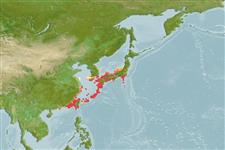Environment: milieu / climate zone / depth range / distribution range
Écologie
marin récifal, usually 2 - 20 m (Ref. 27115). Subtropical; 24°C - 28°C (Ref. 27115)
Northwest Pacific: Matsushima Bay, Japan to Taiwan.
Taille / Poids / Âge
Maturity: Lm ? range ? - ? cm
Max length : 50.0 cm TL mâle / non sexé; (Ref. 9710)
Épines dorsales (Total): 9; Rayons mous dorsaux (Total): 22-24; Épines anales 3-4; Rayons mous anaux: 21 - 23. Body roundish in young, becoming ovate with age. Forehead without rostral prominence even in adult. Caudal peduncle relatively deep and compressed without dorsal and ventral precaudal depressions. Four or 5 bony plates are on each side of the caudal peduncle. Posterior 3 or 4 plates with feeble triangular keels.
Often found in groups in shallow, surge rocky areas (Ref. 9710). Anterolateral glandular groove with venom gland (Ref. 57406).
Life cycle and mating behavior
Maturité | Reproduction | Frai | Œufs | Fécondité | Larves
Masuda, H., K. Amaoka, C. Araga, T. Uyeno and T. Yoshino, 1984. The fishes of the Japanese Archipelago. Vol. 1. Tokai University Press, Tokyo, Japan. 437 p. (text). (Ref. 559)
Statut dans la liste rouge de l'IUCN (Ref. 130435)
Utilisations par l'homme
Aquarium: Commercial
Plus d'informations
Noms communsSynonymesMétabolismePrédateursÉcotoxicologieReproductionMaturitéFraiRassemblement de ponteFéconditéŒufsDéveloppement de l'œuf
RéférencesAquacultureProfil d'aquacultureSouchesGénétiqueElectrophoresesHéritabilitéPathologiesTraitementNutrientsMass conversion
CollaborateursImagesStamps, Coins Misc.SonsCiguateraVitesseType de nageSurface branchialeOtolithesCerveauxVision
Outils
Articles particuliers
Télécharger en XML
Sources Internet
Estimates based on models
Preferred temperature (Ref.
123201): 17.7 - 26.6, mean 22.5 °C (based on 96 cells).
Phylogenetic diversity index (Ref.
82804): PD
50 = 0.5078 [Uniqueness, from 0.5 = low to 2.0 = high].
Bayesian length-weight: a=0.01995 (0.00906 - 0.04395), b=3.01 (2.83 - 3.19), in cm total length, based on all LWR estimates for this body shape (Ref.
93245).
Niveau trophique (Ref.
69278): 2.0 ±0.00 se; based on food items.
Résilience (Ref.
120179): Milieu, temps minimum de doublement de population : 1,4 à 4,4 années (Preliminary K or Fecundity.).
Fishing Vulnerability (Ref.
59153): Moderate vulnerability (40 of 100).
Nutrients (Ref.
124155): Calcium = 25.2 [12.1, 50.0] mg/100g; Iron = 0.543 [0.277, 1.082] mg/100g; Protein = 18.9 [17.6, 20.3] %; Omega3 = 0.14 [0.08, 0.27] g/100g; Selenium = 16.5 [7.0, 36.4] μg/100g; VitaminA = 20.8 [4.3, 95.1] μg/100g; Zinc = 0.86 [0.53, 1.42] mg/100g (wet weight);
